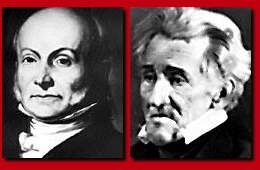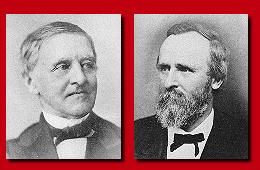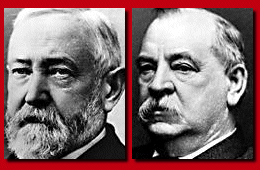|
Controversial
Elections

Below is a list of some of the
more controversial U. S. Presidential Elections. Scroll down for the
whole list or click on a specific year to read the story. You
can also click here to
find a list of third party candidates that have received Electoral
votes in the past.
1800
1824
1836
1872
1876
1888
2000

1800
(Thomas
Jefferson - John Adams)

In the 1800 Presidential election, the Democratic-Republicans
ran Thomas Jefferson and Aaron Burr on their ballot. Jefferson and
Burr won a clear majority of the national vote. All 73 Democratic-Republican members
of the Electoral College voted faithfully, casting two
votes each, one for Jefferson and one for Burr. Before the 12th Amendment, Electors
cast two votes for their party without specifying one as being for
the President and the other as being for the Vice President. Because
of this, Jefferson and Burr received exactly the same number of
Electoral votes and the election was a tie. Since there was no majority within
the Electoral College, the decision was deferred to the
House of Representatives, then controlled by the Federalist Party. Though
Jefferson was clearly the Democratic-Republican�s candidate for President, the
Federalist Party considered Burr to be less
of an evil than Jefferson. They tried to rally support
for Burr in place of Jefferson. Burr also refused to endorse
Jefferson. The House had difficulty
coming to a majority and cast 36 separate votes within one
week. Though the original election was in November, the final House
vote, electing Jefferson as President, did not occur until
February 7, 1800. Aaron Burr was appointed as Vice
President. This election prompted the
passing of the 12th Amendment which introduced double balloting. The
Electoral College now casts two separate votes, one for President
and one for Vice President.
Back To Top

1824
(John Q. Adams - Andrew
Jackson)

This was the first election where the winner of the popular
vote did not become the President. Andrew Jackson won a slight
plurality in the popular vote, leading John Quincy Adams by 38,149
votes. Four candidates received Electoral votes, though none
received enough to constitute a majority:
Andrew Jackson received 99 Electoral votes.
John
Quincy Adams received 84 Electoral votes.
William H. Crawford
received 41 Electoral votes.
Henry Clay received 37 Electoral
votes.
Since there was no majority within the Electoral College, the
decision was deferred to the House of Representatives. The House is
only allowed to vote on the top three contenders from the Electoral
College so Henry Clay was removed from the election. Adams, who was Jackson�s most viable
competition, sought Clay�s
support, knowing it would bring him victory. As the vote neared,
Clay worked hard rounding up support for Adams. He won over Western
representatives whose states had voted solidly for Jackson and even
promised the votes of his home state Kentucky, which had not cast a
single popular vote for Adams. After more than a month of
bargaining, John Quincy Adams took precisely the 13 states he needed
to win, Jackson won seven, and Crawford won four. When Adams became President, he
appointed Henry Clay as Secretary of State. Many have suspected that
the promise of the position was why Clay agreed to support Adams.
Jackson called the whole situation a "corrupt bargain" and spent
the next four years campaigning on how the election was stolen from
him. Though Jackson did win the popular vote in 1824, not all
states recorded a popular vote. In six of the 24 existing states,
the Electoral College members were appointed by the State
Legislature. These six states (NY, SC, GA, VT, LA, DE) comprised
nearly 25% of the electorate. The number of voters for each
Electoral vote also varied considerably. There were more voters in
Indiana, which carried 5 Electoral votes, than there were in
Virginia, which carried 24 Electoral votes. More than three times as
many people voted in Ohio than in Virginia, yet Ohio only cast 16
electoral votes. Some states were won with very
high percentages; Jackson carried 98% of Tennessee�s popular vote,
Adams carried 94% of New Hampshire�s vote. Neither candidate
had national appeal and both were absent on the ballot
in at least one state. Despite these variations in representation, Jackson�s
4-year campaign highlighting the unfairness was successful. He
won the Presidency in 1828, presenting himself as a man of the
people, not the government.
Back To Top

1836
(Van Buren - Richard Johnson)

In the 1836 election, the
Democratic-Republican�s Presidential candidate, Martin Van Buren,
won both the popular vote and the electoral vote. His main competition was the Whig
Party. The Whigs hoped to expose the design of the Electoral College
by running several different candidates in different areas, picking
individuals with a great deal of regional appeal.
The Whigs hoped to win a party majority throughout the
country with this method, which would then allow them to choose the
individual they wished to become President. They were unsuccessful and Martin
Van Buren won the election with nearly 60% of the Electoral votes,
though his popular vote lead was just over 50%. His running mate,
Richard M. Johnson, did not fare so well. Upon hearing the
allegation that Johnson had children with an African-American woman,
the 23 Democratic-Republican Electors of Virginia refused to give
him their votes.
Without those 23 votes, Johnson did
not receive a majority vote within the Electoral College. The decision
was deferred to the Senate where Johnson was finally elected by a
majority vote as the new Vice President.
Back To Top

1872
(Greeley - Grant)

Horace Greeley established the Liberal Republicans
(or Democrats) in protest of incumbent Ulysses S. Grant. Greeley ran
against Grant in the 1872 Presidential election. Though few took
Greeley seriously at first, he gained support throughout the
campaign and eventually gathered 40% of the popular vote, only
800,000 less than Grant. Greeley received a total of 2.8 million votes
and would have received 86 Electoral votes had he not died on
November 29, after the general election but before the Electoral
College convened to cast their votes. With no precedent to guide
them, Greeley�s Electors split the 84 votes among four minor
candidates. Grant had already won an absolute majority of the Electoral votes
so the result of the election was not affected. However, history
was slightly skewed because Grant is credited with defeating
Greeley, 286-0.
Back To Top

1876
(Tilden - Hayes)

One of the most controversial
Presidential elections was between Samuel Tilden and Rutherford B.
Hayes. Tilden, a Democrat, won the popular vote by nearly 250,000 votes,
over 3%. On the night of the election, both candidates, as well
as most of the National media, assumed Tilden was the winner. However,
some Republicans were not willing to give up so easily. The
candidate�s Electoral votes were close and the Republicans contested
20 of them, including 4 from Florida, 8 from Louisiana, 7 from South
Carolina, and 1 from Oregon. Out of these 20 Electoral votes,
Tilden only needed 1 to win the election. Hayes needed all 20.
Without any precedent for this many contested Electoral votes, both
parties agreed to set up a 15 person commission to study the
contested votes and to impartially decide whom each vote should go
to. The commission was made up of 5 Senators, 5 members
of Congress, and 5 Supreme Court Justices. It was originally set up
to include 7 Democrats, 7 Republicans, and one independent who
was expected to be unbiased and nonpartisan. At this time, the
Republicans controlled the Senate and the Democrats controlled the
House. Both parties agreed that the findings of the commission would
be upheld unless overruled by both the House and the Senate. When
the independent who was supposed to serve on the commission was
elected as a Senator, he resigned his position on the commission and
was replaced by a Republican. The commission now had 8 Republicans
and 7 Democrats. Over a series of discussions, the
commission voted along party lines and awarded all 20 votes to Samuel Hayes, the Republican
candidate. Each vote was 8-7, with the Republican majority controlling the decision.
Every decision of the commission was contested by the Democratic
House but was upheld by the Republican Senate. The Democrats
threatened to filibuster but eventually agreed to a resolution that
Hayes would withdraw federal troops from the South, ending
reconstruction and the enforcement of equal voting rights for
blacks. This election was clearly corrupted and has found a place
in every debate over the Electoral College since. For a more complete analysis and
timeline of the 1876 election, see the special website designed by
Harper's
Weekly.
Back To Top

1888
(Harrison -
Cleveland) 
1888 was
another election where the winner of the popular vote did not become
President. Democratic incumbent Grover Cleveland had won the
popular vote by a margin of 0.8% (90,596 out of 11,383,320 votes).
Despite this slim popular victory, Republican Benjamin Harrison won
the Electoral College majority (233 out of 401 votes). Harrison won the
Electoral College without the popular vote by winning slim majorities
in his winning states and suffering considerable losses in his losing
states. Six Southern states favored Cleveland by more than 65%.
The reason for this split was the issue of tariffs. The South
strongly favored lowering of the tariff. The Republicans approved of high
tariffs and were unpopular in the South. Tariff reform gave
Cleveland immense support in the Southern states, but the South
alone was not enough to win the election. When elected in 1884, Cleveland
was the first Democrat elected since before the Civil War. He came
back to challenge and defeat Harrison in 1892.
Back To Top

2000
(Bush -
Gore)


The 2000 Presidential Election was the most recent election where
the popular vote winner was not elected. George W. Bush, son of
former President George H.W. Bush, ran on the Republican ticket against
Democratic candidate, and the sitting Vice President, Al Gore. Though
Gore held a slim popular vote victory of 543,895 (0.5%), Bush won
the Electoral College 271-266, with one Gore Elector abstaining.
The election was plagued with
allegations of voter fraud and disenfranchisement. Rumors of illegal road blocks, unclear
ballots, and uncounted votes, particularly in swing states
like Missouri and Florida, were rampant. Florida became the key state as
the election drew to a close. Consisting of nearly 6 million voters,
Florida was officially won by a margin of 537 votes, after a process
of recounting the votes and a Supreme Court ruling. Voters
complained about confusing ballots and many Florida voters believed
that they accidentally voted for Pat Buchanan, a conservative
running on the Reform ticket, when they meant to vote for Al Gore.
Another significant candidate in the 2000
election was Green Party candidate, Ralph Nader. Nader attracted
just under 3% of voters with a progressive platform focused on
social and environmental issues. Democratic supporters targeted
Nader as being a �spoiler� for Al Gore. Since Nader was
left-of-center, Democrats argued that most of his voters would have
otherwise supported Gore. In such a close election, many believe
that Gore would have won if Nader had dropped out of the race. The 2000
election resulted in numerous court battles over contested ballots
and recounts. These lawsuits escalated to the U.S. Supreme Court
where the final, 5-4 decision was made, ending the recounts and giving
the state of Florida's Electoral votes to George W. Bush.
In
the end, Gore conceded the election publicly, though he did
not hide his displeasure at the Supreme Court�s ruling. Back
to Top
CNN's
Election 2000
Archive: complete timeline of the election and links to
several articles
3 Part Article Series:
2000 Election
Electoral College Table
of Contents
|
